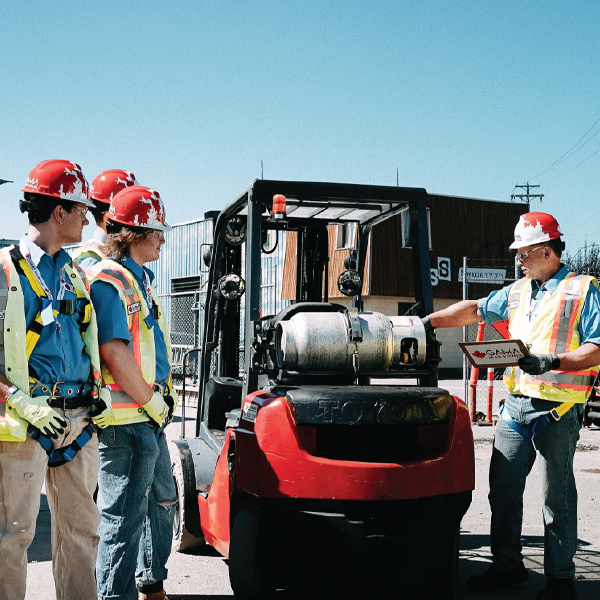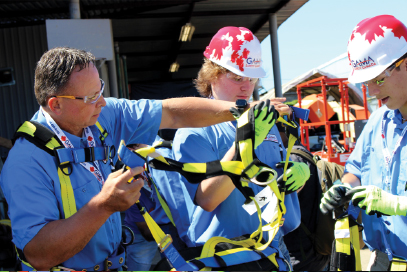Safe Forklift Operation for
Efficient Material Handling and Navigation.
Forklift are essential for material handling in warehouses, factories, and construction sites. Safe operation includes understanding weight limits, load stability, and proper maneuvering to prevent accidents, collisions, or damage to goods and property. Proper forklift training is essential to ensure workplace safety.
Safe Forklift Operation for
Efficient Material Handling and Navigation.
Forklift are essential for material handling in warehouses, factories, and construction sites. Safe operation includes understanding weight limits, load stability, and proper maneuvering to prevent accidents, collisions, or damage to goods and property. Proper forklift training is essential to ensure workplace safety.
OUR PARTNERS AROUND THE WORLD
OUR PARTNERS AROUND THE WORLD
OUR PARTNERS AROUND THE WORLD
OUR PARTNERS AROUND THE WORLD
OUR PARTNERS AROUND THE WORLD
OUR PARTNERS AROUND THE WORLD
OUR PARTNERS AROUND THE WORLD
OUR PARTNERS AROUND THE WORLD
OUR PARTNERS AROUND THE WORLD
OUR PARTNERS AROUND THE WORLD
OUR PARTNERS AROUND THE WORLD
OUR PARTNERS AROUND THE WORLD
OUR PARTNERS AROUND THE WORLD
OUR PARTNERS AROUND THE WORLD
Forklift
Fundamentals
Learn the basic functions of a forklift, including inspection, safe startup, and steering controls on work sites.
Load Handling
and Maneuvering
Discover how to lift, carry, and place loads safely, while maintaining balance, visibility, and control at all times.
Forklift Safety Resources
Training and certification requirements for forklift operators in BC.
WorkSafeBC guidelines on forklift safety and regulatory compliance.
Employer obligations for ensuring forklift safety in the workplace.
Video resource on forklift safety for young workers: staying safe in the cab.
Video showing forklift blind spots and pedestrian safety practices.
Overview of forklift types and material-handling equipment.
Safe handling of propane-powered forklifts and LPG fuel systems.
Causes and prevention of forklift-related accidents.
Operator safety tips and best practices for forklift use.
Forklift Essentials:
Staying Safe While Operating Industrial Lift Trucks
Operating a Forklift is a serious responsibility. These powerful machines are vital to warehouse operations, but they also carry risks if not used correctly. Whether you're new to forklifts or a seasoned driver, safety should always come first. Here are the key essentials for staying safe while operating a forklift:

FORKLIFT
Forklift Essentials:
Safe Operation of Powered Industrial Trucks
Forklifts play a vital role in the daily operations of warehouses, distribution centers, and industrial facilities. They significantly enhance productivity by streamlining the lifting, transporting, and stacking of heavy materials. However, their power and utility also come with serious risks. Improper use can lead to accidents, injuries, or costly damage. That’s why operating a forklift requires not only technical skill but also a strong commitment to safety.
To ensure a safe working environment, every forklift operator must be trained, alert, and aware of their surroundings at all times. Following established safety procedures helps protect not only the operator but also coworkers and company assets. The following key practices outline the fundamental guidelines for the safe and responsible operation of Forklifts.
FORKLIFT Definition
A forklift is a powered industrial truck specifically designed to lift, carry, and transport heavy materials across short distances. It is equipped with a pair of metal forks that slide under pallets or materials, enabling efficient material handling in various environments such as warehouses, factories, shipping yards, and construction sites. Forklifts are indispensable for modern logistics and industrial operations, allowing for the streamlined movement of goods, reduction of manual labor, and improved workflow.
These machines vary in size, capacity, and power source, including electric, propane, diesel, and gas models. Their design can be customized for specific industries or work environments for instance, narrow-aisle forklifts are common in retail storage, while rugged, off-road forklifts are built for construction zones. The versatility and efficiency of forklifts have made them an essential tool in industries that rely on heavy lifting and material movement.
However, forklifts also carry inherent risks. Improper use can result in property damage, injury, or even death. Due to the serious nature of operating such equipment, Canadian law mandates formal training and certification for all forklift operators. Understanding the machine’s purpose and operation is the foundation of safe and effective use in any workplace.
A forklift’s operation relies on several interconnected components that perform specific functions to ensure stability, lifting capability, and operator control. Among the most vital parts are the mast, which raises and lowers loads; the carriage, which supports the forks; and the forks themselves, which lift the load. These components are mounted on a chassis that includes the power source, counterweight, and steering and braking systems, all of which are engineered to provide balance and maneuverability.
The hydraulic system allows for the controlled raising, tilting, and lowering of the mast and forks, giving the operator precise control over load handling. Additionally, the overhead guard protects the operator from falling objects, while the operator’s cab or platform houses the steering wheel, gear selector, and operational controls. Forklift designs may include cushion or pneumatic tires, depending on whether the machine is used indoors or on rough terrain.
Understanding each component is essential not only for safe operation but also for performing routine inspections and maintenance. Operators must be trained to recognize signs of wear, identify potential mechanical failures, and ensure all safety features are intact. Familiarity with these parts enables safer driving, better load management, and extended equipment lifespan.
Forklifts come in various types, each tailored for specific operational needs and environments. The most recognizable is the counterbalance forklift, which features forks at the front and a heavy weight at the rear to balance the load. It’s ideal for general warehouse use and offers excellent versatility. Another popular type is the reach truck, designed for narrow aisles and high stacking in storage facilities. This machine has extending forks and a unique design that allows it to "reach" deep into racking systems.
The rough terrain forklift is built for outdoor use, especially on construction sites. With its large pneumatic tires, high ground clearance, and powerful engine, it can traverse uneven ground while carrying heavy loads. Order pickers allow workers to be lifted alongside the load, making them suitable for retrieving items from warehouse shelves. Additionally, pallet jacks—either manual or powered—are used for low-level lifting and transport of palletized goods within short ranges.
Selecting the right forklift depends on factors such as load weight, lift height, space constraints, and terrain. Using the wrong type of forklift can reduce efficiency, compromise safety, and lead to mechanical issues. Therefore, a thorough understanding of the differences among forklift types is crucial for managers and operators when planning material handling strategies.
The load capacity of a forklift refers to the maximum weight the forklift can safely lift and carry. This value is specified by the manufacturer and is listed on the forklift’s data plate or nameplate. The load capacity varies depending on the design of the forklift, the load’s center of gravity, and how high the load is lifted. Overloading a forklift beyond its rated capacity can cause tipping, loss of control, or mechanical failure, leading to serious safety hazards.
It’s critical to understand that a forklift's load capacity is affected by several dynamic factors. For instance, lifting a load at full height decreases the forklift’s overall stability. Similarly, if the load is placed too far forward on the forks or if the mast is tilted excessively, the forklift can become unbalanced. For this reason, operators must be trained to read and interpret the load capacity chart and understand how different load placements and heights impact the machine’s stability.
Workplace accidents caused by overloading are not uncommon, and they can result in severe injuries, fatalities, and equipment damage. Following the load capacity guidelines helps ensure safe operation and reduces liability. Regular training on load calculation and equipment-specific capacity ratings should be part of every forklift operator’s education.
Forklift training is vital for ensuring the safe and competent operation of a forklift. Operating a forklift without proper training significantly increases the risk of accidents, injuries, and fatalities in the workplace. Certified training programs teach operators how to perform pre-use inspections, understand load handling techniques, operate controls, and follow safety protocols. These programs also emphasize hazard awareness and safe maneuvering in different work environments.
Training not only improves safety but also enhances productivity. Well-trained operators work more efficiently, make fewer errors, and are better equipped to handle unexpected situations such as mechanical failures or emergency stops. Training typically covers both theoretical knowledge and hands-on practice, ensuring that participants understand the forklift’s mechanics, the worksite’s layout, and the importance of communication with ground personnel.
In Canada, forklift training is required by law. Workers must undergo a recognized training program and receive a certificate of competency before being allowed to operate the machinery. Employers are responsible for ensuring their staff are trained and retrained at regular intervals. This legal obligation reinforces the importance of training as a critical component of workplace safety and operational compliance.
Forklifts play a major role in boosting productivity and workflow efficiency across a wide range of industries. By allowing workers to quickly move heavy materials, they reduce the need for manual labor and speed up tasks like loading, unloading, and stacking goods. In warehouses and construction zones alike, forklifts minimize downtime and allow for more streamlined operations, resulting in cost savings and faster project timelines.
In addition to improving speed and material handling capabilities, forklifts help reduce physical strain and injury risks for employees. Tasks that would typically require multiple workers can often be handled by a single forklift operator. This not only reduces labor costs but also allows companies to assign their workforce more strategically. Forklifts also contribute to better inventory management by enabling efficient stacking and space utilization in storage facilities.
When properly maintained and operated by trained personnel, forklifts become powerful assets that enhance operational capacity, reduce workplace hazards, and support long-term business success. Their contribution to workflow optimization makes them one of the most important tools in industrial and commercial environments today.
FORKLIFT Legislation
Yes, forklift training is legally required in Canada under various provincial and federal occupational health and safety regulations. According to the Canadian Centre for Occupational Health and Safety (CCOHS), employers must ensure that all forklift operators are adequately trained and deemed competent before being permitted to use this type of powered equipment. This requirement helps minimize risks associated with improper operation and promotes safer work environments across industries.
The definition of “competent” varies slightly by province but generally includes having the knowledge, training, and experience to perform the work safely, along with the ability to recognize potential hazards. For example, in Ontario, the Occupational Health and Safety Act (OHSA) mandates that employers must take every reasonable precaution to protect workers, including providing proper instruction and supervision for equipment operation. In British Columbia, WorkSafeBC sets the standards for training and certification, requiring a combination of classroom instruction, practical evaluation, and documented proof of competency.
Non-compliance with training laws can result in severe penalties, including fines and stop-work orders, and increases the risk of workplace accidents. Beyond the legal obligation, certified forklift training is a key factor in fostering a culture of safety, protecting workers, and avoiding operational downtime. Training must be current, relevant to the equipment in use, and documented by the employer.
Forklift operations are regulated under both provincial occupational health and safety acts and federal legislation, depending on the industry and jurisdiction. Each province has its own set of regulations. For example, WorkSafeBC governs forklift operations in British Columbia, while Alberta OHS Code, Ontario’s OHSA, and Quebec’s CNESST establish rules in their respective provinces. Federally regulated industries follow the Canada Labour Code Part II, which applies to interprovincial or national employers such as those in telecommunications, banking, and transportation.
These laws outline requirements for training, equipment maintenance, inspections, operator responsibilities, and employer duties. Regulations typically mandate that forklifts be maintained according to the manufacturer’s specifications, that operators be competent and certified, and that specific safety procedures such as wearing seatbelts and observing speed limits are followed. Employers must ensure that hazard assessments are conducted and control measures are in place.
Because legal requirements vary slightly by province, it is the responsibility of both the employer and the operator to be familiar with and adhere to the applicable laws where the work is being conducted. Ignorance of these legal duties is not a defense in the case of an incident, and enforcement officers have the authority to investigate, issue citations, or prosecute violations.
Under Canadian law, employers have a legal duty to ensure a safe working environment, which includes the safe use of powered industrial trucks such as forklifts. This includes providing proper training, supervision, and equipment maintenance. Employers must ensure that only trained and certified individuals operate forklifts, and they are responsible for developing and enforcing safety protocols tailored to their specific worksite.
Employers are also required to conduct regular inspections of the forklifts, maintain up-to-date maintenance records, and immediately address any defects or hazards identified during pre-use checks. Additionally, they must create written procedures for safe operation, provide access to safety data sheets if the forklift uses fuel or other hazardous substances, and ensure the availability of protective gear such as seatbelts or hearing protection.
Failure to meet these obligations can result in serious legal consequences including fines, penalties, or even criminal charges in cases of gross negligence. Furthermore, if an untrained worker is involved in an incident, the employer can be held liable for damages or injuries. Proactively fulfilling these legal responsibilities not only helps with regulatory compliance but also fosters a culture of accountability and safety.
While the specific timeframe for recertification varies by province, most Canadian jurisdictions recommend or require retraining or recertification every three years, or sooner if the operator has been involved in an accident, has demonstrated unsafe behavior, or when there is a change in equipment or workplace conditions. The goal is to ensure ongoing competency and refresh critical safety knowledge.
WorkSafeBC, for example, does not specify an exact timeframe but mandates that operators be assessed for competency on an ongoing basis. Other provinces, such as Ontario, follow CSA Standard B335-15, which recommends retraining every three years. This standard has been widely adopted across Canada as a best practice for maintaining high safety standards in material handling operations.
Employers should document all training and refresher courses and should maintain an internal system to track when recertification is due. This not only ensures compliance with provincial legislation but also enhances operational safety and reduces liability. A well-maintained training log serves as a legal safeguard in the event of an inspection or workplace incident.
Non-compliance with forklift safety legislation can result in fines, legal action, stop-work orders, and in severe cases, criminal prosecution. Provincial safety authorities such as WorkSafeBC, the Ministry of Labour in Ontario, or the CNESST in Quebec have the authority to inspect workplaces and issue citations for violations related to forklift operations. These penalties vary depending on the severity of the infraction and whether it caused injury or death.
Fines can range from hundreds to thousands of dollars per violation, and employers may face escalating penalties for repeat offenses. In cases where negligence leads to serious injury or fatality, individuals and companies may be charged under the Criminal Code of Canada for violating the Westray Bill (Bill C-45), which holds organizations criminally liable for workplace safety failures. Such cases can result in significant financial damage and long-term reputational harm.
Moreover, insurers may refuse to cover damages caused by untrained forklift operation, leading to costly lawsuits and operational disruptions. Ensuring compliance with all applicable forklift legislation is a proactive way to protect workers, maintain a reputable business, and avoid preventable financial and legal consequences.
The term “competent person” is a legal designation defined under Canadian occupational health and safety legislation. While definitions can vary slightly by province, a competent person is generally someone who is qualified through knowledge, training, and experience to perform a task safely. This person also understands applicable legislation and is capable of identifying existing or potential workplace hazards.
For forklift operations, a competent person must have successfully completed a recognized training program that includes theoretical instruction and a practical skills evaluation. The individual must demonstrate the ability to safely operate the equipment in various scenarios, understand the load capacity and mechanical systems, and perform required inspections. Competency is not a one-time designation—it must be reassessed regularly through refresher training, observation, and corrective coaching if needed.
Employers are responsible for verifying and documenting the competency of each forklift operator. If an incident occurs and the operator is found to lack proper training or understanding, the employer may be held legally accountable. Therefore, maintaining a workforce of competent operators is not just a legal requirement—it is a cornerstone of safety and risk management in material handling environments.
Other Courses You May Be Interested In.
Workers who complete FORKLIFT training often continue their safety education with the following programs:"
More Courses
Online Courses
"Explore & Book Online Courses!
Have a Question?
"We’re here to help! Click the button to get in touch."


